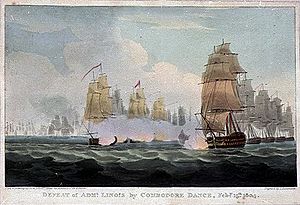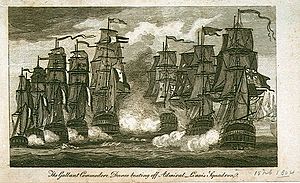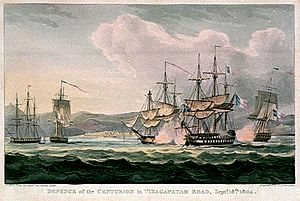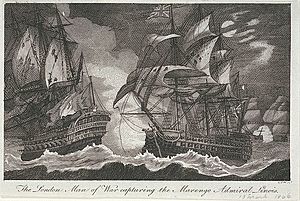Linois's expedition to the Indian Ocean facts for kids

Linois's expedition to the Indian Ocean was a mission by the French Navy during the Napoleonic Wars. Its goal was to attack British merchant ships. In March 1803, French Admiral Charles-Alexandre Durand Linois sailed to the Indian Ocean. He was on his main ship, the Marengo, with three other warships called frigates. This was just before the end of a peace treaty called the Peace of Amiens.
When war started between Britain and France in September 1803, Marengo was at Pondicherry in India. Linois managed to escape a British group of ships sent to catch him. He reached Isle de France (now Mauritius). The British found it hard to gather enough ships to fight Linois because naval bases were far apart. This allowed Linois to continue his mission for three years.
From Isle de France, Linois and his frigates began attacking British trade ships. He especially targeted large groups of East Indiamen. These were big merchant ships vital for trade within the British Empire and for Britain's economy. Linois had some success against single merchant ships and a small British trading post called Bencoolen.
His first big fight was the Battle of Pulo Aura on February 15, 1804. Linois attacked the British China Fleet, which had 16 valuable East Indiamen. But he failed to use his stronger forces and left without capturing any ships. In September 1804, Linois attacked a small British group of ships at Vizagapatam. He captured one ship but was again forced away by weaker British forces.
Marengo was badly damaged and needed major repairs. After more trips in the Red Sea and central Indian Ocean, Linois tried to return to Europe. On his way back, Linois's ships sailed into an area where British ships were operating. He was captured by a much larger force in the action of 13 March 1806. This happened almost exactly three years after he left France.
Linois's actions caused fear and problems in the Indian Ocean. However, the actual damage to British shipping was small. His mission is known more for its failures than its successes. In France, Napoleon was very angry. He refused to exchange Linois for captured British officers for eight years. Linois and his crew remained prisoners of war until 1814.
Contents
Why the Indian Ocean Was Important
In the early 1800s, the Indian Ocean was a very important route for British trade. It connected Britain with its colonies and trading posts in the Far East. Large groups of merchant ships, including the big East Indiamen, sailed from places like China and Australia.
These ships joined other large groups from British India. Together, they carried millions of pounds worth of goods to Britain every year. They crossed the Indian Ocean, sailed around the Cape of Good Hope, and then headed north to Europe. After unloading their goods, they took on new cargo for the return trip. This often included soldiers for the Honourable East India Company (HEIC) in India.
French Raiders in the Indian Ocean
During the French Revolutionary Wars (1793–1801), French warships called frigates and privateers attacked British trade routes. These French ships operated from their colonies of Isle de France and Réunion. The British Royal Navy and the HEIC fleet protected their trade. Still, some individual ships were lost, especially smaller local vessels called "country ships."
Many of these losses were caused by privateers. These were private ships allowed by the government to attack enemy shipping. One famous privateer was Robert Surcouf. He captured the East Indiaman Kent in 1800. However, these losses were a very small part of the total British trade. The large trade convoys continued without stopping. In 1801, the short Peace of Amiens ended the wars. This allowed France to send more ships and soldiers to its colonies in the Indian Ocean.
Why Blockades Were Hard
During the French Revolutionary Wars, the British Navy often blocked French ports. This meant French ships leaving port would face attacks. This strategy caused many losses for the French Navy in Europe.
However, in the Indian Ocean, it was different. The French bases on Réunion and Isle de France were very far from British bases in India. It was too difficult to keep a constant blockade of these islands. This meant French raiders in the Indian Ocean could travel more freely. They faced less risk of being caught than those in the Atlantic or Mediterranean.
Napoleon's Plan
By 1802, tensions grew again between Britain and France. First Consul Napoleon Bonaparte knew war was coming. He ordered the French Navy to prepare a strong force for the Indian Ocean. This force would be able to cause major damage to British trade.
The main ship of this group was the fast ship of the line Marengo. It had 74 guns and was commanded by Admiral Charles-Alexandre Léon Durand Linois. Linois was a very experienced officer. He had fought the British many times before. His most famous victory was in July 1801 at the First Battle of Algeciras.
Marengo was joined by the frigates Atalante, Sémillante, and French frigate Belle Poule 1802 (2). Two transport ships also came along. This group of ships was supposedly sent to take control of Pondicherry in India. They were also meant to bring a new governor, General Charles Decaen. The convoy carried 1,350 soldiers and many supplies for the long journey and future operations.
Linois's Journey in 1803
Linois's ships left Brest on March 6, 1803. The four-month trip to Pondicherry was rough. A big storm on April 28 separated Belle Poule from the group. It had to shelter in Madagascar. The transport ships also got separated.
Belle Poule arrived in India first on June 16. Napoleon had told Linois that war with Britain probably wouldn't start until September. But relations worsened quickly. Britain began preparing for war on May 16 and officially declared war two days later. News traveled slowly, so this news hadn't reached the Indian Ocean yet.
A British officer tried to take control of Pondicherry, but the British officials refused. They were under orders from Lord Wellesley to keep control of the city's trade. A large British group of ships, led by Admiral Peter Rainier, arrived nearby. They were watching French movements.
Linois arrived at Pondicherry on July 11. He saw Rainier's ships nearby and most of the city still in British hands. On July 12, a French ship arrived carrying important news: King George III of Britain had threatened war. Napoleon had ordered Linois to sail immediately to Isle de France. He was to prepare his ships for a long mission attacking British trade.
When dawn broke on July 13, Rainier went to meet Linois for breakfast. But he found that Linois's ships had secretly left during the night. Linois had left so quickly that he abandoned his anchors and boats. He also missed one of his transport ships, which arrived later and was quickly surrounded by British ships.
Linois's ships arrived safely at Isle de France on August 16. General Decaen became governor, and some soldiers were left there. Linois and Decaen had argued on the way to India, and their dislike for each other would affect the mission. News of the war reached Isle de France in late August. Linois added a new ship, the Berceau, to his group.
By October 8, Linois was ready. He sent Atalante to attack ships near Muscat. The rest of his ships sailed with him to Réunion (now called Île Bonaparte) to strengthen its defenses. Then they sailed east to the Dutch East Indies. Along the way, they attacked British ships that didn't know war had started.
Linois's first attacks were successful. He captured several undefended "country ships." In early December, Linois stopped at the British trading town of Bencoolen. The local guide thought Linois's ships were British and led them into the harbor. The French ships attacked the merchant ships there. Six were sunk by their crews, and two more were burned by French landing parties. The French also destroyed three large warehouses full of spices and other goods. They captured three ships. On December 10, Linois's ships arrived at Batavia for the winter.
The Battle of Pulo Aura
On December 28, 1803, Linois's ships left Batavia. They had enough supplies for six months. Linois sailed north into the South China Sea. He wanted to catch the HEIC China Fleet. This was a large group of East Indiamen carrying goods worth £8 million from Canton to Britain.
This yearly group of ships usually had Royal Navy warships protecting them. But in 1804, there was no escort. The war had delayed the British warships. So, as the convoy neared the Straits of Malacca, it had 16 East Indiamen and 13 other ships. They were only guarded by one small HEIC armed ship, Ganges.
On February 14, near the island of Pulo Aura, the convoy's leader, Nathaniel Dance, saw sails approaching. Dance sent some East Indiamen to check. They quickly found out the ships were Linois's French squadron. Dance knew his convoy couldn't win a fight. So, he decided to trick the French. He pretended that some of his large East Indiamen were actually disguised warships.
Dance arranged his ships in a line of battle. He ordered three or four ships to raise blue flags and the others red flags. This made it look like they had a strong escort of warships. This trick made Linois careful. He ordered his ships to follow the convoy without getting too close. During the night, Dance kept his ships in position, and Linois stayed far away, unsure of the British strength.
At 9:00 AM, Dance changed his ships back into a sailing formation to get away. Linois saw this as a chance to attack. He threatened to cut off the last British ships. Dance quickly turned his lead ships around to help the rear. They fired at Marengo from a distance. Linois was surprised by the sudden British move. He turned and retreated, convinced that the convoy was protected by a much stronger force. Dance kept up the illusion of warships and chased Linois for two hours. The convoy then safely reached the Straits of Malacca. Days later, two British warships arrived from India to meet them.
This battle was embarrassing for Linois. He insisted that the convoy had up to eight warships and that his actions saved his squadron. Both his own officers and officials in Britain and France made fun of his story. They criticized him for being too timid and not attacking when such a valuable prize was within his reach. Dance, on the other hand, was praised for his defense. He was given a knighthood and large money gifts.
Linois's Later Operations
Linois arrived back at Batavia after the battle. The Dutch governors criticized him for not defeating the China convoy. Linois then sailed for Isle de France, arriving on April 2. On the way back, his frigates captured several valuable merchant ships.
When Linois arrived, Governor Decaen questioned him about the China Fleet battle. Decaen was not happy with Linois's answers. He sent a harsh letter to Napoleon about Linois. Linois stayed at Isle de France for two and a half months. He finally left with Marengo, Atalante, and Sémillante in late June. Belle Poule was sent on its own mission.
Second Trip: Battle of Vizagapatam
Linois first sailed to Madagascar to attack British trade ships. Bad weather forced him to stay in Saint Augustin for a month. He then sailed to the Ceylon coast. There, he captured valuable ships carrying rice and wheat. He sent them to Isle de France for supplies.
Linois's ships slowly moved north into the Bay of Bengal. In late August, they passed Madras, staying far from the British ships there. He captured some small ships and then searched along the coast for valuable convoys. Prisoners from one captured ship told him about a valuable British convoy at Vizagapatam. It had a frigate and two East Indiamen.
Linois arrived off Vizagapatam on September 15, 1804. He found that the British had replaced the frigate with a larger 50-gun ship, HMS Centurion. Two small East Indiamen were also there. The captain of Centurion was ashore, so Lieutenant James Robert Phillips was in command. He fired at Linois's ships as they approached.
Linois's frigates raised French flags and moved closer. They came under fire from a shore battery. Marengo stayed further out to avoid shallow waters. Phillips ordered the East Indiamen to help, but they didn't. One ship ran aground, and the other refused to fight. The French ships pulled back for repairs. Centurion was badly damaged. The French returned to attack. One East Indiaman surrendered. By 1:15 PM, with Centurion badly damaged and the prize captured, Linois decided to leave. Napoleon later criticized Linois for not destroying the British warship.
With Marengo damaged, Linois left the Bay of Bengal and returned to Isle de France. The British Admiral Rainier tried to find Linois. But Linois's scouts spotted the British ships and he safely reached Grand Port on October 31. As Marengo entered the harbor, its deeper bottom scraped on the coral reefs. The ship's hull was badly damaged, and its rudder was torn off. This needed long repairs.
Linois began major repairs to Marengo. The ship was pulled onto the beach to fix its bottom and rudder. These repairs lasted until May 1805. The cost of feeding and housing the sailors put a strain on Governor Decaen's supplies. To help, Linois sent Atalante to attack trade routes near the Cape of Good Hope. He also sent Sémillante on a mission to the Philippines and then to Mexico. However, Sémillante was badly damaged in a fight with British ships in August 1805. It returned to the Indian Ocean and continued to attack British trade until 1808.
Third Trip: Facing Troubridge
Linois left Isle de France for his third and final trip on May 22, 1805. He first sailed to the Red Sea but found few targets. He then turned east and by July was again attacking ships off Ceylon. On July 11, he found his richest prize yet, the large East Indiaman Brunswick. He also found another ship, Sarah.
Linois sent Belle Poule to chase Sarah. The captain of Sarah ran his ship onto the beach to avoid capture. The crew got ashore as the ship broke apart. Brunswick was slower. Its captain fired at Marengo, but the fight was short. Brunswick quickly surrendered to the larger French ship.
In early 1805, Admiral Sir Edward Pellew took command at Madras. He was a more aggressive officer. When he learned Linois was off Ceylon, Pellew sent ships to find him. Linois learned about Pellew's ships from captured prisoners and left, avoiding a fight.
After another unsuccessful trip to the Red Sea, Linois sailed south. He wanted to find trade routes between the Cape of Good Hope and Madras. During this journey, his ships were caught in a bad storm. Belle Poule lost its mizenmast (a mast at the back of the ship). Linois was able to replace it, but he had no spare masts left. This made his ships vulnerable, so he decided to protect his masts at all costs.
On August 6, 1805, Linois found a group of eleven large ships sailing east. It was foggy, so Linois was careful. He didn't want to attack until he was sure there were no British warships among them. At 4 miles away, it became clear that one ship was a large warship. This was HMS Blenheim, a 74-gun ship. It was commanded by Captain Austen Bissell and carried the flag of Admiral Sir Thomas Troubridge. Blenheim was the only escort for ten East Indiamen.
Just like at Pulo Aura, the East Indiamen formed a line for battle. And again, Linois refused to attack directly. Blenheim was a powerful ship. Linois worried it could badly damage Marengo. Instead, Linois tried to get behind the convoy to cut off a straggler. But his captured ship, Brunswick, was too slow and fell behind.
At 5:30 PM, Marengo got close enough to the last East Indiaman and fired from a distance. Belle Poule joined in. The British ship Cumberland fired back. Blenheim held its position, letting the convoy pass ahead. The French ships quickly came up to Blenheim. Troubridge fired heavily, driving the French ships away. Linois, worried about his masts, sailed away quickly. By 6:00 PM, he was out of range.
At midnight, the French ships crossed in front of the convoy. By morning, they were 4 miles to the south. Troubridge kept his ships in line. At 7:00 AM on August 7, 1805, he prepared for another attack as Linois approached. But the combined fire of the East Indiamen and Blenheim stopped Linois from attacking. He turned away and disappeared that night. Linois's mainmast had been hit during the brief firing. If the fight continued, it might have collapsed. The French had few casualties. The British had slightly more, with one passenger and one sailor killed. No British ships were seriously damaged. The convoy continued its journey and arrived safely at Madras on August 23.
Return to the Atlantic
After the encounter with Blenheim, Linois sailed west. He arrived at Simon's Bay in the Dutch colony of Cape Town on September 13. He hoped to join the Dutch ships there. But he found only one Dutch warship, which was not ready for sea. Linois spent two months repairing his ships and getting supplies. In October, Atalante joined him.
On November 5, a strong storm hit the bay. Atalante lost its anchors and was wrecked on shore. The crew escaped, and 160 men were left to help defend Cape Town. Linois's captured ship, Brunswick, was also wrecked nearby.
Linois left Simon's Bay on November 10. He slowly sailed up the West African coast, looking for British ships. He only captured two small merchant vessels. He learned from an American ship on January 29, 1806, that the British had captured Cape Town. With no safe harbor nearby and needing repairs, Linois decided to return to Europe. He sailed north, following trade routes. On March 13, he was at a specific location in the Atlantic.
The Atlantic Campaign of 1806
Unknown to Linois, he was sailing into a major naval campaign. After the Battle of Trafalgar in October 1805, the British had reduced their blockade of French ports. They thought the French Navy was too weak to respond. But the French Brest fleet was still strong. Napoleon ordered two groups of ships to sail on December 15, 1805. They were to attack British merchant ships and avoid strong British forces.
When the British learned the French ships had left Brest, they sent two groups of their own ships to chase them. One French group was destroyed in February 1806. The other British groups remained in the mid-Atlantic, waiting for the remaining French ships. One British group, led by Admiral Sir John Borlase Warren, was ordered to sail near Madeira. This was directly in Linois's path.
Linois is Captured
At 3:00 AM on March 13, 1806, lookouts on Marengo saw sails in the distance. Linois thought they were merchant ships and ordered his ships to advance. It was dark, so visibility was poor. Linois didn't realize what he was facing until the 98-gun British ship HMS London appeared right in front of him. London's captain had seen Linois's ships and sailed to investigate. He sent signals to the rest of Warren's squadron.
Linois tried hard to turn Marengo away from the large British ship. But his ship was too slow. London opened fire, and a battle began. Both ships were badly damaged. Belle Poule helped Linois, but when the British frigate HMS Amazon arrived, Linois ordered Belle Poule to escape. Belle Poule sailed away, with Amazon chasing it.
At 6:00 AM, Linois tried to get Marengo away from London. But his ship was too damaged to move well. London's fire continued. At 8:30 AM, Amazon reached Belle Poule and fired, badly damaging its rigging. By 10:25 AM, the French situation was hopeless. Nearly 200 men were killed or wounded, including Linois. Both French ships were badly damaged and couldn't move. Other British warships were also getting close. Realizing defeat was certain, the most senior officer on Marengo surrendered. Belle Poule surrendered soon after.
Warren returned to Britain with his captured ships. British losses were 14 dead and 27 wounded. French losses were 69 dead and 106 wounded. Warren was praised for his victory. Both French ships were taken into British service. This battle marked the end of Linois's mission, three years and seven days after he left France. Unlike his earlier battles, Linois was praised for his bravery in this final fight against stronger forces.
What Happened Next
Linois's actions in the Indian Ocean caused a lot of worry for British merchants and officials. This was mainly because of the threat he posed to the East Indiaman convoys, like the one at Pulo Aura. However, the actual damage he caused was small. In three years, he captured only five East Indiamen and a few country ships. He briefly caused fear in 1804 but didn't cause major economic problems for British trade.
His only real achievement was forcing the British to use their ships to defend convoys and ports. This stopped them from doing offensive attacks. The vast distances, lack of supplies, and strong British escorts all played a part in Linois's failures. But historians and people at the time mostly blamed Linois's own poor leadership. He avoided putting his ships in danger, spent too much time in French harbors, and didn't use his advantage even when he had an undefended target.
Linois and his men remained prisoners in Britain until the end of the war. Napoleon refused to exchange them. Napoleon's anger at Linois's failure would have prevented him from getting any more commands. But in 1814, King Louis XVIII made him Governor of Guadeloupe. When Napoleon returned to power during the Hundred Days, Linois was the only French colonial governor to support him. Within days, a small British force removed him. Linois's career was over, and he died in 1848.
The Indian Ocean remained a battleground for the next four years. French frigate groups from Isle de France continued to attack British merchant ships. These were led by Captain Motard, who was more successful than Linois. Later, Commodore Jacques Hamelin took command. His group caused more damage in one year than Linois did in three. Eventually, British forces captured Isle de France in December 1810, ending the French presence in the Indian Ocean.
Order of Battle
| Admiral Linois's Squadron | ||||||||||
|---|---|---|---|---|---|---|---|---|---|---|
| Ship | Guns | Commander | Notes | |||||||
| Marengo | 74 | Contre-Admiral Charles-Alexandre Léon Durand Linois Captain Joseph-Marie Vrignaud |
Main ship, captured on March 13, 1806. | |||||||
| Belle Poule | 40 | Captain Alain-Adélaïde-Marie Bruilhac | Participated in key battles, captured on March 13, 1806. | |||||||
| Sémillante | 36 | Captain Léonard-Bernard Motard | Participated at Pulo Aura and Vizagapatam. Later operated independently. | |||||||
| Atalante | 40 | Captain Camille-Charles-Alexis Gaudin-Beauchène | Participated at Vizagapatam, wrecked in September 1805. | |||||||
| Berceau | 20 | Captain Emmanuel Halgan | Joined in August 1803, participated at Pulo Aura, returned to France. | |||||||
| Aventurier | 16 | Lieutenant Harang | Joined in December 1803, participated at Pulo Aura. | |||||||
| Source: James, Vol. 3, p. 176, Clowes, p. 58 | ||||||||||




